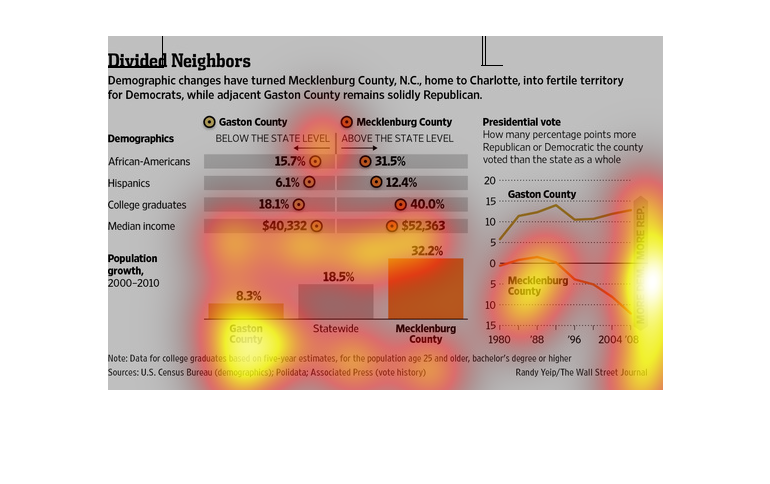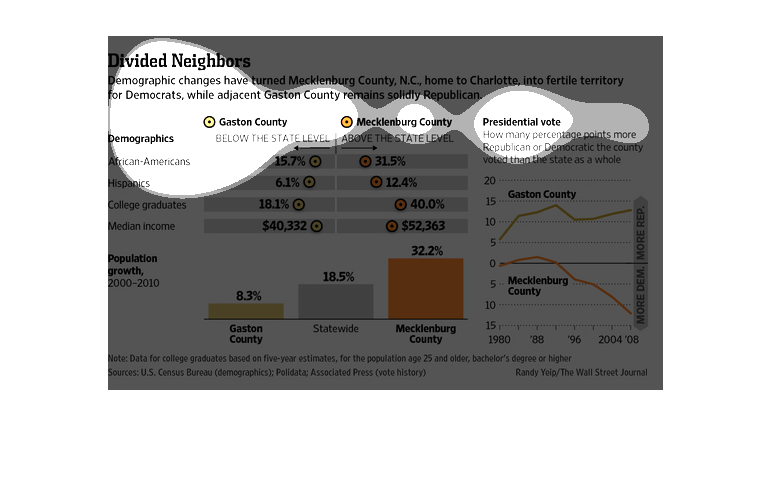
These are graphs that appear to indicate the socioeconomic differences between Mecklinburg
County and Gaston County in North Carolina. On the left is a graph indicating the number of
African Americans, Hispanics, college graduates and the average income there, showing that
those numbers are all below the State Median in Gaston and above it in Mecklinburg. On the
lower left is a graph indicating population growth in which Gaston is below the state average
and Mecklinburg above. On the right is a graph suggesting that Gaston became more Republican
between 1980 and 2008 as Mecklinburg became more Democrat.


This image shows the difference in political parties between two counties (Gaston County and
Mecklenburg County). It shows that Mecklenburg county is basically a home for the Democratic
party, while its neighboring county of Gaston, remains solidly republic.


This chart describes divided neighbors. Specifcally, demographic changes have turned Meckleburg
County, N.C., home to Charlotte, into fertile territory for Democrats.


This chart is for Mecklenburg county in North Carolina and its adjacent county, Gaston county.
Gaston which is mostly republican has seen an 8.3% increase in population in the last decade
while Mecklenburg, which is mostly Democratic, has seen an increase if 32.2% to its population.
Causing confutation.


The image depicts demographic changes in North Carolina, comparing two counties in which one
has become a democratic county and the other remaining a republican county. Some state statistics
included as well.


Make love, not love; people need to really come together and appreciate each other for who
they are. In this study we see that neighbors aren't always friends, an political divides
run deep.


An voter demographic infographic for Mecklenberg County in North Carolina. Charlotte is strongly
democratic while neighboring gaston is solid republican.


This is a Wall Street Journal article describing the demographic changes in Mecklenburg County,
NC and how these changes have given Democrats an advantage. These changes are compared to
neighboring Gaston County, which remains Republican.


This graph/chart displays that during the course of research, they have found that in North
Carolina that one part of a county has major Democrats, while another county has Republicans.


This chart compares demographic and political affiliation changes between Mecklenburg County
and Gaston County in North Carolina. Mecklenburg county has had significant population growth,
mostly of African Americans. Voters in Mecklenburg County are much more likely to vote Democrat
than they were in the 80's.


This graph shows political party preferences for Mecklenburg County (primarily Democrat) and
Gaston County (primarily Republican) in North Carolina. The line graph shows that the amount
of Democrats in Mecklenburg is slowly decreasing, whereas the amount of Republicans in Gaston
County is increasing.


This is a series of color coded charts and graphs depicting the demographic changes had turned
Mecklenburg County, NC into fertile ground for Democrats.


This is a series of graphs and charts and related statistics depicting that demographic changes
in Mecklenburg County, North Carolina had turned it into fertile ground for Democrats.


This charges about the amount of unemployment and average salary in a bunch of counties and
state wide. I'm not sure what state it is it also has the political tendencies of the country


This chart describes divided neighbors. Specifically, demographic changes have turned Mecklenburg
county, NC, home to Charlotte, into fertile territory for democrats.
































